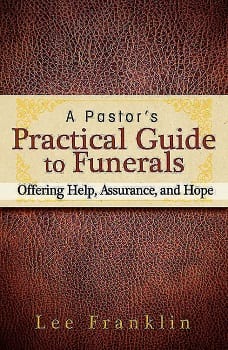Working with a family during the time of death is one of the privileges of pastoral ministry. Bereavement work is far more than a funeral liturgy. Yet many of us have only experienced a couple of class periods in a seminary course preparing us for this task. Most of us could use some help in becoming more effective in this important act of Christian ministry.
Lee Franklin is a hospice chaplain in the Dallas-Fort Worth area and is an ordained pastor in the Christian Church (Disciples of Christ). In his recent book, A Pastor’s Practical Guide to Funerals: Offering Help, Assurance, and Hope, pastors have a resource to help us grow in our capacity to “offer help, assurance, and hope.”
Franklin starts with a narrative perspective, a recognition that in the face of death five stories intersect: God’s story, the story of the dying or deceased, the stories of the grieving, the pastor’s story, and the stories of the congregation. He unpacks the importance of each of these stories and offers practical suggestions about how a pastor might engage them. This chapter alone is worth the book.
In chapter two, Franklin deals with ways to offer pastoral care when death is anticipated. He discusses nine key principles for effective care during times of long-term illness: (1) respect and honor the sacred process of dying and death; (2) recognize that the funeral process begins before death; (3) take the office of pastor seriously; (4) attend to family systems; (5) help the dying persona and the family prepare for death; (6) involve the congregation in care; (7) facilitate anticipatory grieving; (8) be prepared to be a liaison among the dying person, family, and medical personnel; and (9) be attentive to intersections with God’s story.
Chapter three takes the reader through ministry at times when death comes suddenly and unexpectedly. The suggestions about ministry during such times are concrete and practical. Franklin offers the “ABC’s of Pastoral Intervention”: Attend to immediate needs of those most affected by the death; Be aware of the situation and stories of other grievers, the congregation, the pastor, and God; and Carry out commitments made through initial contacts. He also deals with the ways in which cross-cultural ministry during such times can affect the pastor’s role and in the ways in which suicide presents a unique circumstance.
Chapter four describes in detail the process of meeting with a family before the funeral, listening to their stories, hearing the story of the deceased, and preparing for the funeral itself. Franklin discusses the function of the funeral, returning to the narrative basis of the five intersecting stories described in the first chapter.
In the fifth chapter Franklin leads the reader through the concrete steps of creating the funeral service. He includes many examples and a list of FAQs (“What does the pastor do when the deceased was a difficult person?” “What about secular music in a funeral service?”)
Franklin takes up the funeral sermon in chapter six. He describes its unique function and offers several examples. Chapter seven offers solid suggestions for following up with those who are grieving. The book also contains appendices of forms that could be helpful in the process and a suggested reading list for each chapter.
Seminary students and seasoned pastors would find Franklin’s work helpful and would likely improve their bereavement ministry significantly by implementing even a few of his suggestions.
Recommended by Dr. R. Robert Creech, Professor of Christian Ministries and Director of Pastoral Ministries at Truett Seminary
